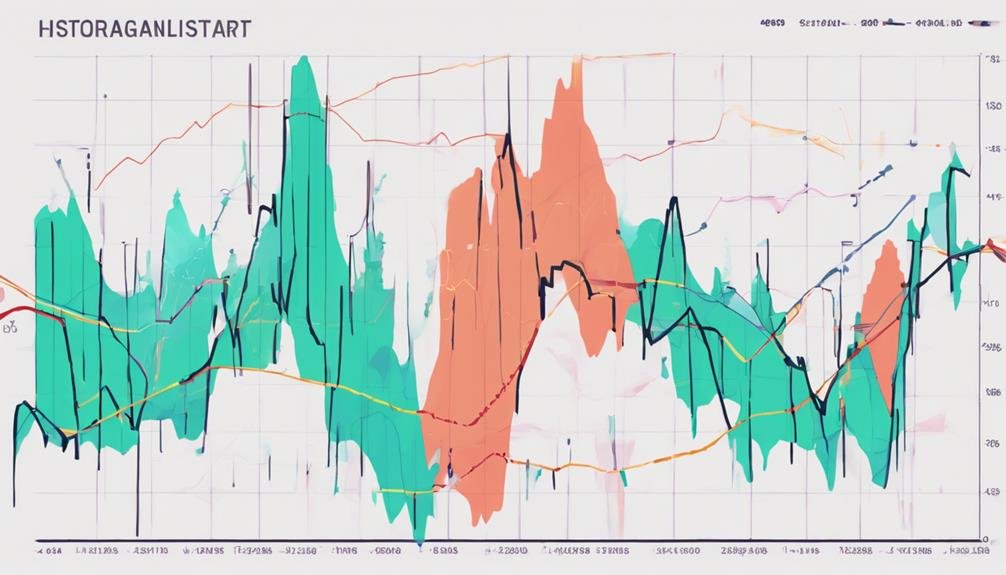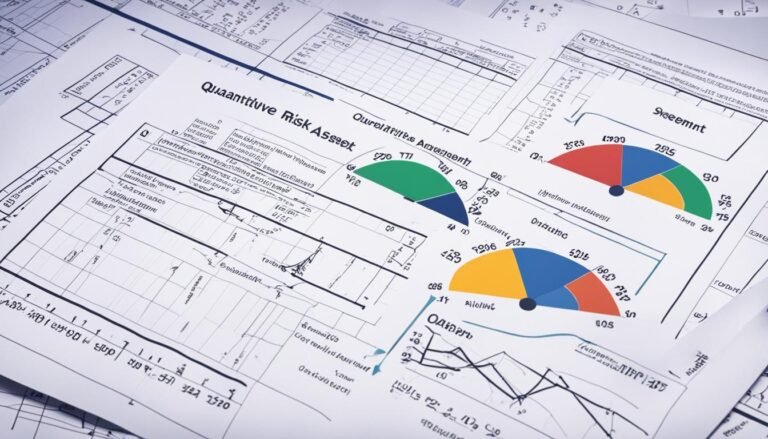Time Series Analysis in Finance
Delving into the domain of finance, time series analysis is a powerful tool that allows you to track and trace trends over time. Have you ever wondered how this method can assist in uncovering hidden patterns and insights within financial data?
By employing sophisticated models and techniques, time series analysis provides a lens through which to peer into the future and make informed decisions. As you navigate through the intricacies of this analytical approach, be prepared to witness the impact it can have on forecasting and strategic planning in the financial sphere.
Key Takeaways
- Sequential data analysis reveals patterns for forecasting in finance.
- Visualization and stationarity tests aid in trend identification and data quality assessment.
- Models like ARIMA predict future values crucial for informed financial decisions.
- Time series analysis supports stock price forecasting, trend detection, and risk management in finance.
Understanding Time Series Data
To understand time series data effectively, you must grasp the sequential nature of observations and the potential patterns they may reveal in financial analysis. Data visualization techniques play a critical role in this process by providing a visual representation of the data over time. By plotting time series data, you can identify trends, seasonality, and irregularities that may impact financial decision-making.
In addition to data visualization, statistical tests for stationarity are essential in analyzing time series data. Stationarity is a key concept in time series analysis that implies the statistical properties of the data remain constant over time. By conducting statistical tests for stationarity, such as the Augmented Dickey-Fuller test, you can determine if a time series is stationary or exhibits trends and seasonality. This information is crucial for selecting appropriate models and making accurate forecasts in financial analysis. By combining data visualization techniques and statistical tests for stationarity, you can gain valuable insights from time series data in finance.
Key Concepts in Time Series Analysis
Exploring fundamental concepts is essential for mastering time series analysis in finance. Two key concepts critical to this analysis are data preprocessing techniques and time series visualization techniques. Data preprocessing involves cleaning, transforming, and organizing data to enhance its quality and prepare it for analysis. On the other hand, time series visualization techniques help analysts gain insights by graphically representing the data over time.
To further understand these concepts, let's dive into a table that highlights some common techniques:
| Key Concepts | Description | Example |
|---|---|---|
| Data Preprocessing | Techniques to clean, transform, and organize data for analysis. | Removing outliers |
| Handling missing data | ||
| Time Series Visualization | Methods to visually represent time-dependent data for analysis and interpretation. | Line charts |
| Techniques | Candlestick charts |
Mastering these key concepts will lay a solid foundation for your journey into time series analysis in finance.
Time Series Models in Finance
Time series models in finance play an important role in analyzing and forecasting financial data trends. These models are essential for making informed decisions in the dynamic world of finance. Predictive modeling is a key aspect of time series models, allowing analysts to forecast future market movements based on historical data patterns. By utilizing statistical techniques, such as autoregressive integrated moving average (ARIMA) or exponential smoothing methods, financial experts can identify trends, seasonality, and irregularities within the data.
When constructing time series models in finance, it's vital to select the appropriate model that best fits the data characteristics. Different models, such as ARIMA, GARCH (Generalized Autoregressive Conditional Heteroskedasticity), or VAR (Vector Autoregression), offer various strengths in capturing different aspects of financial data behavior. These models enable analysts to assess risk, predict market fluctuations, and optimize investment strategies based on historical data patterns. By leveraging predictive modeling and statistical techniques, time series models empower finance professionals to make strategic decisions with a quantitative foundation.
Applications of Time Series Analysis
You can apply time series analysis in finance for forecasting stock prices, detecting market trends, and developing risk management strategies.
By utilizing historical data patterns, you can make informed predictions about future stock price movements.
Identifying market trends through time series analysis can help you adapt investment strategies to capitalize on emerging opportunities and mitigate risks efficiently.
Forecasting Stock Prices
Utilizing time series analysis techniques, investors can predict future stock prices with statistical models based on historical data. By analyzing trends and patterns, investors can make informed decisions.
Some methods include:
- Moving Averages: Smooth out price data to identify trends over time.
- Autoregressive Integrated Moving Average (ARIMA): Models based on the time series data to predict future prices.
- Seasonal Decomposition: Separates data into trend, seasonal, and residual components to understand patterns better.
These techniques, along with technical indicators and machine learning techniques, provide investors with valuable insights for forecasting stock prices. By leveraging historical data effectively, investors can make more informed decisions in the financial markets.
Detecting Market Trends
Market trends can be effectively detected through the application of time series analysis techniques. Identifying trends is important in finance for making informed decisions. By analyzing historical data, you can spot patterns that indicate market movements. Statistical significance plays a key role in confirming the reliability of these trends.
Utilizing methods like moving averages or exponential smoothing can help in trend identification. Data visualization tools such as line charts or candlestick charts aid in interpreting these trends visually. Market trend detection isn't a crystal ball, but a systematic analysis of data points over time. Understanding the statistical significance of trends can provide valuable insights for investors and traders alike.
Risk Management Strategies
Identifying and managing risks through the application of time series analysis techniques is fundamental in financial decision-making. When it comes to risk management strategies, time series analysis plays an important role in evaluating and mitigating potential risks. Here are key ways it's applied:
- Portfolio Optimization: Time series analysis helps in optimizing investment portfolios by analyzing historical data patterns and predicting future trends.
- Credit Risk: By utilizing time series analysis, financial institutions can evaluate credit risk more accurately, allowing for better decision-making in lending practices.
- Risk Assessment: Time series analysis enables the identification of potential risks by analyzing historical data patterns, helping in developing proactive risk management strategies.
Forecasting With Time Series Data
When analyzing financial time series data, forecasting future trends is a critical aspect that requires accurate modeling techniques. Predicting trends and analyzing patterns are essential for making informed decisions in finance. One common method used for forecasting with time series data is Autoregressive Integrated Moving Average (ARIMA) modeling. ARIMA models consider the dependencies in the data and aim to predict future values based on past observations. Here is an example table illustrating the forecasted values for a hypothetical stock price using ARIMA modeling:
| Time Period | Actual Price | Forecasted Price |
|---|---|---|
| 1 | $100 | $98 |
| 2 | $105 | $102 |
| 3 | $98 | $100 |
| 4 | $110 | $105 |
| 5 | $115 | $108 |
Implementing Time Series Analysis
Moving from forecasting future trends with time series data, the next step involves practical application through the implementation of time series analysis techniques. To effectively implement time series analysis, you must prioritize data preprocessing techniques to ensure data is clean, consistent, and ready for analysis. This step is essential as the quality of your analysis heavily depends on the quality of your data.
Some key data preprocessing techniques include:
- Imputation of missing values
- Handling outliers
- Normalizing or standardizing data
Once your data is preprocessed, the next essential aspect is evaluating the models you have created. Model evaluation metrics play a significant role in determining the accuracy and reliability of your time series analysis. It's essential to use metrics such as Mean Absolute Error (MAE), Root Mean Squared Error (RMSE), and Mean Absolute Percentage Error (MAPE) to assess the performance of your models accurately.
Conclusion
You have explored into the world of time series analysis in finance, uncovering key concepts, models, and applications.
By forecasting with time series data, you can gain valuable insights for making informed decisions.
Remember, the proof is in the pudding when it comes to implementing time series analysis effectively.
Keep your eyes on the prize and continue to refine your skills in this data-driven field.







